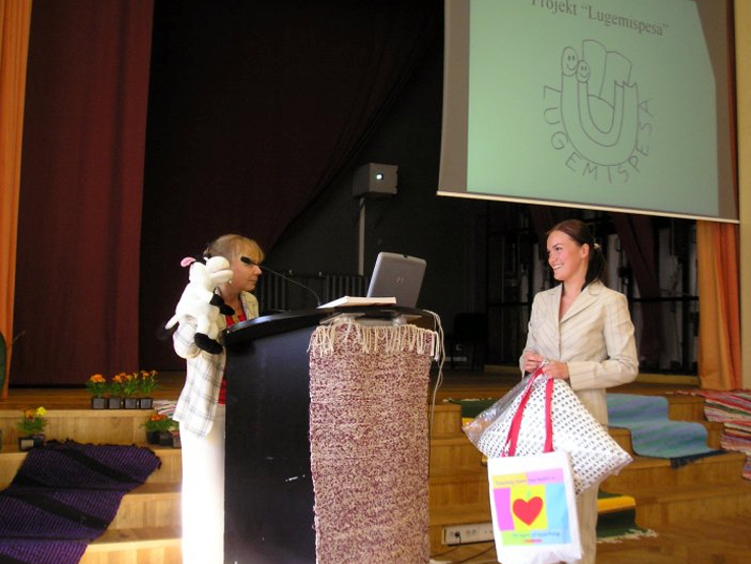HISTORY
The project “Reading Nest” of the Estonian Reading Association was born in 2004 with the aim of providing teachers with new skills on how to adjust the reading environment in pre-school and primary school, and make books and reading activities more attractive to children. Later the idea spread into libraries, homes and elsewhere.
The project “Reading Nest” was launched in order to:
-
Increase children’s interest in books and reading;
-
Support children’s initiative and creativity;
-
Grow positive behaviour through good use of children’s free time;
-
Foster the development of learning skills and prevent learning problems related to low reading experience;
-
Inspire teachers with new ideas and views and encourage their creativity;
-
Involve parents in the cooperation between home and school, encourage parents to set up a literacy environment at home too;
-
Include community in the work of a school.
The idea of a new reading environment was introduced by the then chair of the Association Meeli Pandis in 2003, who was enthused at a training course for the Step by Step programme in Lithuania where child-centred learning in activity centres, incl. reading centres, was presented. This gave rise to an idea to also popularise reading centres in those kindergartens and schools where the Step by Step methodology was not used, and involve families and community in helping to set up such centres and arrange activities.
It was a lucky coincidence that the Embassy of the Netherlands had opened an application round for MATRA-KAP projects and Maili Liinev (née Vesiko), a student of special education at Tallinn University was interested in writing her master’s paper on the topic of reading. The name “reading nest” was suggested at a family discussion by Meeli’s daughter Made, and communicates the sense of safety and cosiness which initiators of the project wished to emphasise.
The Association’s logo was designed by speech therapist Kadi Künnapuu at a training course for mentors of reading nests.
At an Association’s meeting the objectives and an activity plan of the project were drawn up, a system of mentoring was devised and an application for funding was written which proved successful. The project was officially launched in August 2004 with the first training seminar for future mentors at Tallinn University. The topics covered were: setting up, operating and furnishing a reading nest, children’s different reading styles, skills and interest in reading, and training for adults. The course had 86 participants, of whom 54 became active mentors of reading nests. One group of mentors comprised teachers from Russian-speaking schools and kindergartens, consecutive interpretation was made available for them.
From the very beginning the project aimed to disseminate knowledge on literacy environments and to ensure these ideas reach as wide an audience as possible. In October and November 2004 the first 54 mentors trained teachers all over Estonia, each in their own region. Each mentor trained and supervised 10-25 teachers. Modern research-based approaches to reading as well as the importance of a reading environment were introduced to participants, along with practical advice on how to set up reading nests in classrooms. In the first project year 1042 kindergarten and primary school teachers attended training in total. On the whole the project included 194 institutions: 112 kindergartens, 68 schools and 14 primary schools with kindergarten groups.
The project received funding from the Embassy of the Netherlands in its first year, as of 2006, funding was provided from the Gambling Tax Council. By the year 2012 the Reading Nest had outgrown its project-phase and evolved into a training system whose vision is “the reading nest as a mentality”.
To this day, within the Reading Nest project, over 200 mentors and over 4000 teachers have been trained across Estonia.
The Reading Nest is the Reading Association’s most successful initiative, which is still very much in full swing. A special feature of the project was that it was largely based on voluntary input, and from the very beginning dissemination of information from teachers to teachers followed the snowball effect principle. Setting up a network, collaboration with like-minded colleagues, sharing experiences and learning from each other have been valued highly from the word ‘go’. The Association’s annual conferences have brought together practitioners with their fresh ideas and latest research results.
The project has been practical and hands on. Simple guidelines help teachers to realise what the essential features of a literacy environment are and how to create a similar environment in a classroom. It is extremely important that mentors as project trainers are also practising teachers. They have set up a reading nest in their classroom and can tell from first-hand experience how such a place can impact children’s motivation to read and develop literacy and what wonderful things may be undertaken in the nest.
The Reading Nest project’s first project manager Maili Liinev (née Vesiko) defended her master’s thesis “The reading environment in a children’s establishment: setting up and operating a reading nest” at the Chair of Special and Social Education of the Faculty of Educational Sciences of Tallinn University.
The quantitative study included 227 primary school and kindergarten teachers, who had participated in a training course delivered by a mentor of the project. The thesis also contained a case study, in the course of which a reading nest was established, then its operation was studied, and opinions of the teachers and children were investigated.
Meeli Pandis and Maili Liinev at the annual conference of the Estonian Reading Association in 2005.

Anneli Laamann, the Reading Nest project manager for North Estonia and Kaja Kivisikk, the Reading Nest project manager for South Estonia at the conference in Tartu in 2010.


